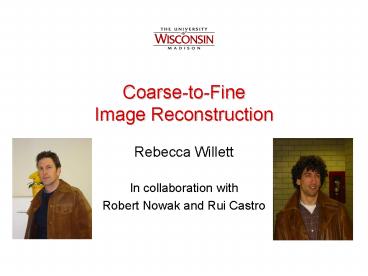CoarsetoFine Image Reconstruction - PowerPoint PPT Presentation
1 / 40
Title:
CoarsetoFine Image Reconstruction
Description:
with high probability, pruned coarse partition close. to optimal coarse partition ... square containing a boundary fragment is pruned in the first stage (this may ... – PowerPoint PPT presentation
Number of Views:30
Avg rating:3.0/5.0
Title: CoarsetoFine Image Reconstruction
1
Coarse-to-FineImage Reconstruction
- Rebecca Willett
- In collaboration with
- Robert Nowak and Rui Castro
2
Poisson Data 14 photons/pixel MSE 0.0169
3
Iterative reconstruction
(Willett Nowak, IEEE-TMI 03)
E-Step Compute conditional expectation of new
noisy image estimate given data and current
image estimate
Traditional Shepp-Vardi M-Step Maximum
Likelihood Estimation
Improved M-Step Complexity Regularized
Multiscale Poisson Denoising
4
Wedgelet-based tomography
Shepp-Logan
MLE
Wedgelet-based reconstruction
Jeff Fesslers PWLS
5
Tomography
6
A simple image model
piecewise constant 2-d function with smooth
edges
7
Measurement model
Access only to n noisy pixels
8
Image space
9
Kolmogorov metric entropy
10
Dudley 74
11
Minimax lower bound
approx. err
estimation err.
12
Adaptively pruned partitions
13
Tree pruning estimation
14
Partitions and Estimators
15
Complexity Regularization and the Bias-Variance
Trade-off
Complexity penalized estimator
set of all possible tree prunings
16
The Li-Barron bound
Li Barron, 00 Nowak Kolaczyk, 01
17
The Kraft inequality
1
1
1
1
0
1
1
1
1
1
0
0
0
0
0
0
0
0000
0000
0000
0000
0000
18
Estimating smooth contours - Haar
Decorate each partition set with a constant
squared approximation error
19
Approximating smooth contours - wedgelets
Donoho 99
20
Approximating smoother contours
(Donoho 99)
Haar Wavelet Partition
Original Image
gt 850 terms
lt 370 terms
21
Estimating smoother contours - wedgelets
Use wedges and decorate each partition set with a
constant
squared approximation error
22
The problem with estimating smooth contours
Haar-based estimation
Wedgelet estimation
23
Computational implications
24
A solutionCoarse-to-fine model selection
two-step process involves search first over
coarse model space
from which one is selected
space of all signal models is very large
25
Coarse-to-fine model selection
second step involves search over small subset of
models
26
C2F wedgelets two-stage optimization
Start with a uniform partition
Stage 1 Adapt partition to the data
by pruning
Stage 2 Only apply wedges in the
small boxes that remain
27
C2F wedgelets two-stage optimization
28
Error analysis of two-stage approach
(Castro, Willett, Nowak, ICASSP 04)
29
Controlling variance in the preview stage
- Start with a coarse partition in the first stage
- lowers the variance of the coarse resolution
estimate - with high probability, pruned coarse partition
close to optimal coarse partition - unpruned boxes at this stage indicate edges or
boundaries
30
Controlling bias in the preview stage
- Bias becomes large if a square containing a
boundary fragment is pruned in the first stage
(this may happen if a boundary is close to the
side of the squares) - Solution
- Compute TWO coarse partitions - one normal, and
one shifted - Refine any region unpruned in either or both
shifts
31
Computational implications
32
Main result in action
noisy data MSE 0.0052
stage 1 result MSE 0.1214
stage 2 result O(n7/6), MSE 0.00046
33
C2F limitations The ribbon
34
C2F and other greedy methods
Matching pursuit
Boosting
35
More general image models
36
Platelet Approximation Theory
Twice continuously differentiable
Twice continuously differentiable
- m-term approximation error decay rate
- Fourier O(m-1/2)
- Wavelets O(m-1)
- Wedgelets O(m-1)
- Platelets O(m-2)
- Curvelets O(m-2)
37
Confocal microscopy simulation
Noisy Image
Haar Estimate
Platelet Estimate
38
C2F limitations complex images
- Images are edges many images consist almost
entirely of edges - C2F model still appropriate for many
applications - nuclear medicine
- feature classification
- temperature field estimation
39
C2F in multiple dimensions
40
Final remarks and ongoing work
- Careful greedy methods can perform as well as
exhaustive searches, both in theory and practice - Coarse-to-fine estimation dramatically reduces
computational complexities - Similar ideas can be used in other scenarios
- Reduce the amount of data required (e.g., active
learning and adaptive sampling) - Reduce number of bits required to encode model
locations in compression schemes

